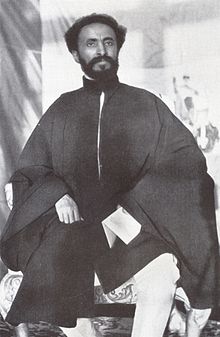 Haile Salassie I (1892-1975)
Haile Salassie I (1892-1975)
Ethiopian Emperor from 1930 to 1974
Haile Salassie I, was originally called Ras (Prince) Tafari Makonnen. He took the name Haile Selassie, meaning “Instrument in the Power of the Trinity,” when he became emperor. His early life was marked by tragedy. His 10 brothers and sisters were killed in a boating accident when he was a child, and his father died when he was 15. Ras Tafari was crowned Emperor on November 2, 1930, after the death of Empress Zauditu. He took the title Haile Selassie I, King of Kings, Conquering Lion of Judea, and Elect of God, and immediately moved to establish Ethiopia as a modern state. He abolished slavery, instituted a constitution, and set up an appointed, advisory parliament and a more modern judiciary.
In 1935, Italy, which already controlled Eritrea and Italian Somaliland, invaded Ethiopia. Though Ethiopia was able to field an army of 1,000,000 men, it was not able to cope with air strikes, poison gas warfare, and modern mechanized assault tactics. Haile Salassie I was forced to flee in 1936, but return in 1941 when the British, with the aid of Ethiopian guerrillas, recaptured the country.
Under Haile Salassie I, Ethiopia became one of the charter members of the United Nations, and a leader in the establishment of the Organization of African Unity. When he first came to power, there were fewer than 10 schools throughout the country. Twenty- five (25) years later there were over 10,000. His autocratic rule, combined with famine in the Horn of Africa, resulted in unrest in the 1960s. He was over-thrown by a military coup in 1974 and murdered the following year. In addition to his legacy in Ethiopia, Haile Selassie I became one focus of Rastafarianism, a religion in Jamaica that derives its name from Haile Selassie’s original name, Ras Tafari
RASTAFARIANISM: A religion that developed in Jamaica in the 1930s and that continues to have a widespread impact. Rastafarians believe that the Ethiopian emperor Haile Selassie I was a direct descendant of the biblical King Solomon and the Queen of Sheba and was a living god. The Belief in the holiness of Haile Selassie derived from Marcus Garvey’s prophecy that an African King will arise who would unite all the black peoples in the world. Rastafarians do not cut their hair, nor does the men shave, their hair hangs in long twisted strands “dreadlocks”. Rastafarians see themselves as the reincarnation of the ancient Hebrews of Israel, and their interpretation of biblical scriptures differs substantially from mainstream Christian and Jewish doctrine. Rastafarian beliefs focus on the oppression of black peoples around the world, the future overthrow of wicked, repressive governments (referred to symbolically as Babylon), and the eventual triumph of the poor and righteous. Though many Rastafarians are vegetarians and refrain from using alcoholic beverages, the use of marijuana or “ganja”, is an important part of various Rasta rituals, especially “Groundation,” during which Rastafarians reaffirm their beliefs. Among the most famous Rastafarians was legendary Bob Marley.
Details taken from Susan Altman’s “Ency. of Afro.-Amer. Heritage”

